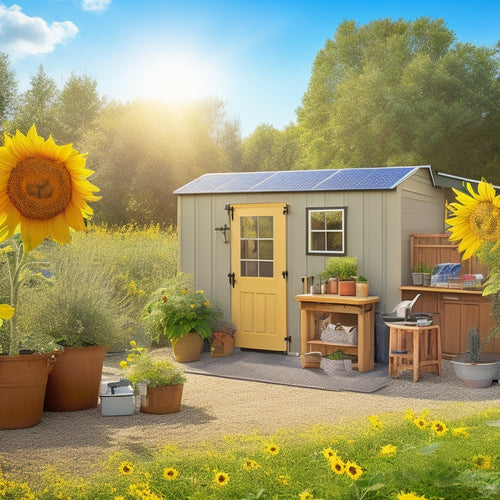
7 Best Home Battery Chargers Using Renewable Energy
Share
You're looking for a reliable and efficient way to utilize renewable energy for your home, and that's where the best home battery chargers come in, providing a sustainable solution to store and employ excess energy generated from solar panels, wind turbines, or hydroelectric power systems. Leading brands like Goal Zero and Anker Powerhouse offer high-performance solutions, while advanced technologies like lithium-ion batteries and MPPT charge controllers optimize energy storage and distribution. As you investigate the world of renewable energy, you'll find out how these innovative systems can reduce your carbon footprint, lower energy bills, and provide independence from traditional power grids - and there's more to reveal.
Overview
- Top solar battery charger brands like Goal Zero and Anker Powerhouse offer efficient and portable solutions for off-grid energy storage.
- High-capacity energy storage systems integrate renewable sources like solar and wind to reduce carbon footprint and promote sustainable living.
- Efficient energy harvesting components, such as advanced power conversion and smart energy management, optimize energy distribution and storage.
- Long-lasting deep cycle batteries with high cycle life ratings provide reliable energy storage for off-grid systems, ensuring consistent energy availability.
- Advanced MPPT charge controllers regulate energy flow from solar panels to battery systems, maximizing solar efficiency and performance monitoring.
Top Solar Battery Charger Brands
With the growing demand for eco-friendly solutions, you're likely considering utilizing the power of solar energy to charge your batteries. When it comes to top solar battery charger brands, you'll want to look for ones that offer seamless solar panel compatibility and portable charging solutions.
Brands like Goal Zero and Anker Powerhouse lead the pack, offering efficient and reliable charging options.
Explore top-rated solar battery brands such as Tesla, LG, and SimpliPhi, known for their innovative technology and performance. Goal Zero's Yeti series, for instance, is designed for off-grid expeditions, while Anker's Powerhouse 200 is perfect for camping trips or backyard gatherings.
Both brands boast excellent solar panel compatibility, ensuring you can utilize the sun's energy wherever you go. By choosing a reputable brand, you'll be well on your way to charging your batteries sustainably and freely.
High-Capacity Energy Storage Systems
As you scale up your renewable energy system to meet large scale energy needs, you'll require high-capacity energy storage systems that can efficiently harvest and store energy.
This is particularly vital when dealing with intermittent energy sources like solar or wind power, where energy generation can be unpredictable.
To guarantee a reliable power supply, it's critical to evaluate off-grid energy needs and consider factors like maximum power requirements and energy usage patterns.
With efficient energy harvesting, you can secure a stable and reliable power supply, even when the sun isn't shining or the wind isn't blowing.
Large Scale Energy Needs
How do you power a small town or a commercial complex that requires massive amounts of energy on a daily basis? You need high-capacity energy storage systems that guarantee renewable integration and energy resilience.
Large scale energy needs demand sustainable solutions that provide grid independence and reliable power management. Load balancing is essential to mitigate the environmental impact of your energy usage.
Advanced battery systems, such as those using lithium-ion cell chemistry, can detect and store excess energy from renewable sources, allowing for efficient storage and distribution.
By diversifying your energy sources, you reduce your reliance on the grid and minimize your carbon footprint.
When selecting energy storage technologies, consider the battery lifespan and its ability to support your energy needs.
With the right system, you can enjoy freedom from grid constraints and a cleaner, more sustainable energy future.
Efficient Energy Harvesting
Three key components of efficient energy harvesting are critical to high-capacity energy storage systems: advanced power conversion, smart energy management, and strong battery design. You need these elements to guarantee maximum energy efficiency and minimize energy waste.
Advanced power conversion enables you to utilize renewable energy from various sources, such as solar or wind power, and convert it into usable electricity. Smart energy management systems optimize energy distribution and storage, while strong battery design provides reliable and sustainable energy storage.
Efficient Off-Grid Power Solutions
By integrating renewable energy sources with advanced battery charging systems, you can create efficient off-grid power solutions that provide reliable and sustainable electricity.
This enables you to live off-grid lifestyles, free from the constraints of traditional power grids.
With efficient off-grid power solutions, you can utilize the energy from solar panels, wind turbines, or hydroelectric generators to charge your batteries, providing a sustainable and renewable source of power.
This approach allows you to adopt sustainable practices, reducing your reliance on fossil fuels and minimizing your carbon footprint.
Long-Lasting Deep Cycle Batteries
Your deep cycle batteries serve as the backbone of your off-grid power system, storing excess energy generated by your renewable sources for later use. To guarantee a reliable and efficient system, you need batteries that can withstand the demands of deep cycle performance. This means choosing batteries with a long lifespan, capable of handling frequent charge and discharge cycles.
| Battery Type | Lifespan (Years) |
|---|---|
| Flooded Lead-Acid | 5-7 |
| AGM (Absorbed Glass Mat) | 7-10 |
| Gel Cell | 10-12 |
| Lithium-Ion | 12-15 |
| Ni-Fe (Nickel-Iron) | 15-20 |
When selecting deep cycle batteries, look for those with a high cycle life rating, which indicates the number of charge and discharge cycles they can handle before capacity drops. This will guarantee your batteries continue to perform well over their lifespan, providing you with the freedom and independence you desire from your off-grid power system.
Renewable Energy for Home Appliances
With a reliable deep cycle battery bank in place, you're now ready to utilize the power of renewable energy to run your home appliances.
You can capture the energy from the sun with solar panel integration, allowing you to charge your batteries and power your appliances. This setup gives you energy independence, reducing your reliance on the grid and saving you money on your electricity bill.
You'll need to evaluate the size and type of solar panels, as well as the charge controller and inverter, to guarantee a seamless integration with your battery bank.
Advanced MPPT Charge Controllers
One essential component in your renewable energy setup is the charge controller, which regulates the flow of energy from your solar panels to your battery bank.
Advanced MPPT (Maximum Power Point Tracking) charge controllers take it to the next level by optimizing energy conversion and ensuring maximum solar efficiency. These smart controllers continuously monitor your system's performance, adjusting energy flow to match your battery's state of charge and load requirements.
With MPPT technology, you'll get the most out of your solar panels, even on cloudy days or during partial shading. Look for controllers that offer system compatibility, grid interaction, and load balancing features for seamless renewable integration.
Cost-Effective Solar Power Systems
When you're considering a cost-effective solar power system, you'll want to factor in the upfront system installation costs, which can vary depending on the type and quality of equipment, as well as the complexity of the installation.
However, these initial costs can be offset by the long-term energy savings benefits, which can add up quickly, especially if you're currently relying on grid power.
System Installation Costs
By opting for a cost-effective solar power system, you'll not only reduce your carbon footprint but also save big on system installation costs.
The installation process involves several budget considerations, including the type and quality of equipment, labor costs, and permits. A cost-effective system will help you allocate your budget efficiently, ensuring you get the most bang for your buck.
For instance, opting for a grid-tied system can be more affordable than an off-grid system. Additionally, choosing a reputable installer with competitive pricing can help reduce labor costs.
Energy Savings Benefits
Your cost-effective solar power system starts paying you back from day one, generating clean energy and slashing your electricity bills. You'll enjoy significant savings on your energy costs, which adds up to a substantial amount over time. With a home battery charger using renewable energy, you'll experience the benefits of energy independence and sustainable living.
| Monthly Savings | Annual Savings |
|---|---|
| $50 | $600 |
| $100 | $1,200 |
| $150 | $1,800 |
| $200 | $2,400 |
| $250 | $3,000 |
These savings will give you a sense of freedom from relying on the grid and contribute to a cleaner environment. By utilizing renewable energy, you're taking an essential step towards a sustainable future.
Frequently Asked Questions
Can I Use a Home Battery Charger With a Wind Turbine?
You can definitely use a home battery charger with a wind turbine, ensuring wind turbine compatibility and ideal battery charger efficiency, allowing you to utilize the power of the wind and store it for later use with ease.
Are Renewable Energy Battery Chargers Compatible With All Appliances?
You'll find that most renewable energy battery chargers are compatible with standard appliances, but it's essential to check the charger's type, like MPPT or PWM, to verify seamless integration with your specific devices, assuring freedom from energy constraints.
Do I Need a Professional to Install a Home Energy Storage System?
You'll likely need professional assistance to guarantee your home energy storage system meets installation requirements, as it involves complex electrical work, but don't worry, it's worth it for the freedom to utilize renewable energy and reduce your reliance on the grid.
Can I Expand My Energy Storage Capacity in the Future?
You're building a foundation, laying bricks for a sustainable future. As you construct your energy independence, you'll want to guarantee your energy storage technologies are designed with future scalability in mind, allowing you to easily add more bricks, expanding your capacity as your needs grow.
Are There Any Government Incentives for Renewable Energy Systems?
You're likely eligible for government incentives like tax credits, energy rebates, and solar incentives, which can greatly offset the cost of your renewable energy system; investigate installation grants, net metering, renewable subsidies, and funding options to maximize your savings and energy independence.
Ready to Buy
You've got the power to utilize renewable energy and store it efficiently with the best home battery chargers. By investing in top solar battery charger brands, you'll enjoy high-capacity energy storage systems that provide efficient off-grid power solutions. With long-lasting deep cycle batteries, you can run your home appliances seamlessly. Advanced MPPT charge controllers guarantee maximum energy harvesting, while cost-effective solar power systems make it all affordable. By going green, you'll reduce your carbon footprint and save on energy bills - a win-win for you and the planet.
Related Posts
-

Is This the Future of Alternative Energy Systems
Yes, alternative energy systems are shaping the future of energy. Innovations in solar and wind technologies are driv...
-

Building an Emergency Backup Solar Power System in 5 Essential Steps
Building an emergency backup solar power system involves five key steps. First, assess your daily energy needs to ide...
-

Solar Powered Lights for Sustainable Home Decor
Solar-powered lights offer a stylish and eco-friendly way to enhance your home decor. They capture sunlight, converti...


